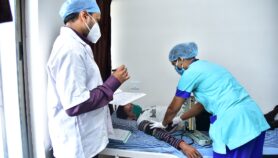Send to a friend
The details you provide on this page will not be used to send unsolicited email, and will not be sold to a 3rd party. See privacy policy.
North-South partnerships dominate university funding in Tanzania, but they are failing to build capacity, says Johnson M. Ishengoma.
Government cuts in research and development (R&D) funding for higher education institutions have compelled public universities in Sub-Saharan Africa to establish extensive partnerships with universities, technology and research centres in the North.
Part survival strategy and part response to the globalization of higher education, these partnerships also coincide with the increasing dominance of external donor funding of R&D in the region.
But have these North-South partnerships and funding streams strengthened higher education and capacity building?
I argue that in Tanzania, they have had limited impact. They have not contributed to meaningful capacity building either by expanding student enrolment, increasing the quantity and quality of higher education support infrastructure, or helping develop and retain academic staff.
Three failures
External donor funding contributed about 70 per cent of Tanzania’s R&D expenditure in 2006. [1] But in 2008, the Southern African Regional Universities Association reported Tanzania’s participation rate in higher education as 7 per 100,000 population per year — lower than elsewhere in East Africa (the number was 41 in Kenya and 19 in Uganda).
There are three reasons for the limited impact of North-South partnerships. First, the structure of partnerships means that most are one-sided. "Academic partnerships have been and continue to be rooted in the assumptions, understandings, and practices of foreign aid and must be understood in those terms," argues Joel Samoff, from Stanford University, United States, who has conducted extensive research on education and development in Tanzania. [2]
The relationship between the donor and recipient is neither reciprocal nor equal. In practical terms, universities in the South have very little financial, human or technology resources to offer those in the North.
Second, some partnerships perpetuate a long-standing dependence on resources from the North that itself results from underfunding and budget cuts by governments. In Tanzania, external donor funding for research in some public universities increased from 81.4 per cent in 1999–2000 to 90.4 per cent in 2004–2005.
Third, a significant portion of donor funding for R&D in Tanzania public universities (as in other African universities) is in the form of indirect aid and project mechanisms that do little to strengthen higher education capacity.
For example, the Partnership for Higher Education in Africa (PHEA), which has funded a plethora of unsynchronized projects in African universities for the last ten years, eventually came to a close last year because US-based foundations could no longer financially support it.
Exacerbating brain drain
There is also evidence from Tanzanian public universities that some research partnerships have been counterproductive, exacerbating brain drain.
For example, a study I conducted revealed that over five years the equivalent of 8.3 per cent of academic staff employed by the University of Dar es Salaam in 2007/08 — mainly senior members of the academic staff — left the University to work with donor-funded research partnerships and projects, nongovernmental organisations and in politics. [3]
Anecdotal evidence also shows that some senior academics in our public universities spend most of their time working on partnerships, donor funded research and consultancies to supplement their meagre salaries. In most cases, this level of involvement is not reported to the university authorities.
Because of the absence of strong monitoring and evaluation mechanisms, most donor-funded partnerships and links largely benefit individual academics. Most — if not all — African public universities lack the institutional capacity to monitor partnerships.
And there is a problem with efficiency. Most partnerships and links established with our public universities are in the form of projects or programmes that do not integrate into the development path, mission and visions of our universities. This also limits how much they can contribute to significant capacity building.
Partnerships are managed as part of student and staff exchange programmes, without clear guiding policies and procedures or relevant organisational structures. This means they are not synchronized or harmonized under one office. These extensive partnerships should be managed by personnel trained in project management, international education or higher education.
Better fit, better function
For North-South partnerships to succeed in strengthening capacity in our universities, their administration, structure, project and aid mechanisms, and content should change so they fit within and work to support the development path, missions and visions of our universities.
Partnerships with our public universities must be initiated and owned by our universities.
And partnerships, sponsors and financiers should consider adopting Delivering as One, the best practice adopted by UN organisations operating in Tanzania, and ‘basket funding’ (pooled funding) mechanisms.
Finally, there is an urgent need to strengthen and consolidate links between universities in the South. These are the partnerships which are likely to work — because higher education institutions in the South face common problems.
Governments in countries of the South should mobilize their own resources to fund both North-South, and South-South partnerships between universities.
Johnson M. Ishengoma is a senior lecturer in the School of Education at the University of Dar es Salaam, Tanzania; a member of the Comparative and International Education Society (CIES); and a founding member of the African Network for the Internationalization of Education (ANIE) and the Tanzania US State Alumni Association (TUSAA).
References
[1] Madikizela, M. Mapping research systems in developing countries — country report: the science and technology system of Tanzania [873kB] (UNESCO, 2006)
[2] Samoff, J and Bidemi, C. The promise of partnership and continuities of dependence: external support to higher education In Africa. African Studies Review 47, 67–199 (2004)
[3] Ishengoma, J. M Internal brain drain and its impact on higher education institutions’ capacity building and human resource development in Sub-Saharan Africa: The case of Tanzania [51.2kB]. (Conference of Rectors, Vice Chancellors and Presidents of African Universities, 2007)













